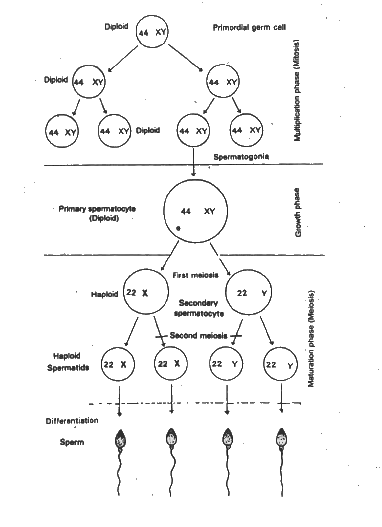Describe the process of spermatogenesis upto the formation of spermatids. Mention the fate of spermatids.
Text Solution
Formation of haploid sperms from the diploid spermatogonial cells of the testes is called spermatogenesis. Primordial germ cells give rise to spermatogonial cells and sertoli cells. It is the spermatogonial cells that develop into the spermatozoa. Spermatogenesis involves four phases., viz..
a.Multiplication Phase b. Growth Phase
c.Maturation Phase d. spermiogenesis
(a) Multiplication Phase: The diploid spermatogonial cells of the seminiferous tubules divide repeatedly by mitosis to form more spermatogonial cells. Among them only a few will enter into growth phase and others are kept reserve.
(b) Growth Phase: Spermatogonial cells obtained from multiplication phase grow in size, however they still remain diploid. These cells are now called primary spermatocytes.
(c) Maturation Phase: This phase involves two successive divisions, viz., Meiosis I and Meiosis II. The meiosis I is reductional and two haploid cells are formed from each primary spermatocyte. The resultant cells of I meiotic division are called secondary spermatocytes. These secondary spermatocytes undergo meiosis II which is equational. As a result each secondary spermatocyte produces two haploid cells of equal size called spermatids. Hence, four haploid spermatids are formed during maturation phase from each diploid primary spermatocyte.
(d) Spermiogenesis: Spermatids are not gametes, they are ordinary haploid cells. During spermiogenesis or spermateliosis each spermatid in association with sertoli cells become tadpole like, flagellated and highly motile gamete called spermatozoan orsperm.

|
Topper's Solved these Questions
- SUPER MODEL QUESTION PAPER 1Book:SUBHASH PUBLICATIONChapter:SUPER MODEL QUESTION PAPER 1Exercise:ANSWER THE FOLLOWING QUESTIONS IN ONE WORD OR ONE SENTENCE EACH
Explore 10 Videos
- SUPER MODEL QUESTION PAPER 1Book:SUBHASH PUBLICATIONChapter:SUPER MODEL QUESTION PAPER 1Exercise:PART B
Explore 8 Videos
- SUPER MODEL QUESTION PAPER 1Book:SUBHASH PUBLICATIONChapter:SUPER MODEL QUESTION PAPER 1Exercise:PART-D (SECTION-I)
Explore 6 Videos
- SUPER MODEL QUESTION PAPER (FOR PRACTICE) 3Book:SUBHASH PUBLICATIONChapter:SUPER MODEL QUESTION PAPER (FOR PRACTICE) 3Exercise:PART-D (SECTION-II)
Explore 5 Videos
- SUPER MODEL QUESTION PAPER 2Book:SUBHASH PUBLICATIONChapter:SUPER MODEL QUESTION PAPER 2Exercise:PART D
Explore 11 Videos
Similar Questions
Knowledge Check
A spermatid is:
AdiploidBtriploidChaploidDpolyploid
Describe the process of cleavage upto the formation of blastocyst
View SolutionDescribe the process of megasporogenesis upto fully developed embryo sac formation in an angiosperm.
View SolutionDescribe the process of megasporogenesis upto fully developed embryo sac formation in an angiosperm.
View SolutionGive the term for change of spermatid into sperm.
View SolutionThe phase of transformation of spermatide into sperm is called
View SolutionThe phase of transformation of spermatide into sperm is called
View Solution" The process of transformation of a spermatid to a spermatozoan in called :- "
View Solution

